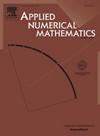Weak Galerkin spectral element methods for elliptic eigenvalue problems: Lower bound approximation and superconvergence
IF 2.4
2区 数学
Q1 MATHEMATICS, APPLIED
引用次数: 0
Abstract
Lower bound approximation and super-convergence of the weak Galerkin spectral element method for second-order elliptic eigenvalue problems are comprehensively investigated in this paper. At first, we establish the approximation spaces with diverse polynomial degrees of weak functions and weak gradients by using the one-to-one mapping from the reference element to each physical element. General weak Galerkin triangular/quadrilateral spectral element approximation schemes are then proposed for the eigenvalue problem of the second-order elliptic operators. A study on the well-posedness of our schemes is carried out, resulting in the constraint conditions on the polynomial degrees of the discrete weak function space and the discrete weak gradient space. Further, qualitative numerical analysis and numerical investigation are performed on a series of polynomial degree configurations for the weak function space and the weak gradient space. We obtain in the sequel the super-convergence of the numerical eigenvalues with the weak Galerkin spectral element methods for the first time, and discover some lower bound approximation scenario that has never been reported before in literature.
椭圆型特征值问题的弱Galerkin谱元方法:下界逼近和超收敛
本文全面研究了二阶椭圆型特征值问题的弱Galerkin谱元法的下界逼近和超收敛性。首先,利用参考元素到各物理元素的一对一映射,建立了弱函数和弱梯度具有不同多项式次的近似空间;针对二阶椭圆算子的特征值问题,提出了一般的弱Galerkin三角/四边形谱元逼近格式。研究了这些格式的适定性,得到了离散弱函数空间和离散弱梯度空间的多项式次的约束条件。在此基础上,对弱函数空间和弱梯度空间的一系列多项式次构型进行了定性数值分析和数值研究。本文首次用弱伽辽金谱元方法得到了数值特征值的超收敛性,并发现了一些文献中从未报道过的下界近似情形。
本文章由计算机程序翻译,如有差异,请以英文原文为准。
求助全文
约1分钟内获得全文
求助全文
来源期刊

Applied Numerical Mathematics
数学-应用数学
CiteScore
5.60
自引率
7.10%
发文量
225
审稿时长
7.2 months
期刊介绍:
The purpose of the journal is to provide a forum for the publication of high quality research and tutorial papers in computational mathematics. In addition to the traditional issues and problems in numerical analysis, the journal also publishes papers describing relevant applications in such fields as physics, fluid dynamics, engineering and other branches of applied science with a computational mathematics component. The journal strives to be flexible in the type of papers it publishes and their format. Equally desirable are:
(i) Full papers, which should be complete and relatively self-contained original contributions with an introduction that can be understood by the broad computational mathematics community. Both rigorous and heuristic styles are acceptable. Of particular interest are papers about new areas of research, in which other than strictly mathematical arguments may be important in establishing a basis for further developments.
(ii) Tutorial review papers, covering some of the important issues in Numerical Mathematics, Scientific Computing and their Applications. The journal will occasionally publish contributions which are larger than the usual format for regular papers.
(iii) Short notes, which present specific new results and techniques in a brief communication.
 求助内容:
求助内容: 应助结果提醒方式:
应助结果提醒方式:


